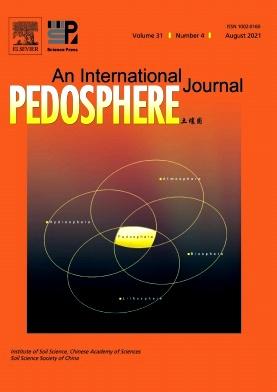氮肥管理是 phoD 群落组装和 pqqC 关键分类群动员土壤磷的必要条件
IF 7.3
2区 农林科学
Q1 SOIL SCIENCE
引用次数: 0
摘要
细菌中存在phoD和pqqC基因,它们分别通过矿化有机磷(Po)和溶解无机磷(Pi)来调动磷(P)。phoD-和pqqc -细菌(分别为phoD-和pqqC-HB)的群落特性介导P循环。然而,phoD-和pqqC-HB的微生物群落组合和关键类群是否调控磷的有效性以及这两个基因之间的不同调控途径尚不清楚。本研究研究了4种长期(38年)施肥方案:无肥对照(CK)、磷肥对照(PF)、氮肥和磷肥对照(NP)和氮肥、磷肥和粪肥对照(NPM)下土壤微生物群落特征和磷有效性。与不施氮处理(CK和PF)相比,施氮处理(NP和NPM)显著改变了群落组成,增加了phoD-和pqqC-HB的丰度。phd -和pqqC-HB的群落聚集均以随机过程为主,随N的增加,随机性的相对贡献增大。此外,与未施氮处理相比,施氮处理增加了phoD-和pqqC-HB的网络复杂性和重要类群丰度。与磷循环有关的关键类群也与碳(C)和氮循环过程有关。微生物群落组成和组装过程是phoD-HB不稳定Pi的主要驱动因子,而关键类群对pqqC-HB不稳定Pi的贡献最大。这些结果强调了phoD-和pqqC-HB在施肥管理下调控磷有效性的不同机制,强调了微生物群落组合和关键分类群在土壤生态功能中的重要性,为理解微生物促进土壤质量的生物过程提供了新的视角。本文章由计算机程序翻译,如有差异,请以英文原文为准。
Nitrogen fertilization management is required for soil phosphorus mobilization by phoD-harboring bacterial community assembly and pqqC-harboring bacterial keystone taxa
phoD and pqqC gene occurrence in bacteria allows them to mobilize phosphorus (P) by mineralizing organic P (Po) and solubilizing inorganic P (Pi), respectively. Community characteristics of phoD- and pqqC-harboring bacteria (phoD- and pqqC-HB, respectively) mediate P cycling. However, whether the microbial community assembly and keystone taxa of phoD- and pqqC-HB regulate P availability and distinct regulatory pathways between these two genes remain unclear. In this study, soil microbial community characteristics and P availability were investigated in four long-term (38-year) fertilization regimes: control with no fertilizer (CK), P fertilizer (PF), nitrogen (N) and P fertilizers (NP), and N fertilizer, P fertilizer, and manure (NPM). The N addition treatments (NP and NPM) significantly changed the community composition and increased the abundances of phoD- and pqqC-HB compared to the no-N addition treatments (CK and PF). Stochastic processes dominated the community assembly of both phoD- and pqqC-HB, and the relative contributions of stochasticity increased with N addition. Furthermore, the N addition treatments resulted in greater network complexity and higher abundances of keystone taxa of phoD- and pqqC-HB compared to those of the no-N addition treatments. The keystone taxa implicated in P cycling were also associated with carbon (C) and N cycling processes. Microbial community composition and assembly processes were the main factors driving labile Pi for phoD-HB, whereas keystone taxa contributed the most to labile Pi for pqqC-HB. These results emphasize that distinct mechanisms of phoD- and pqqC-HB regulate P availability under fertilization management and underline the significance of microbial community assembly and keystone taxa in soil ecological functions, offering fresh perspectives on comprehending the biological processes facilitated by microorganisms in enhancing soil quality.
求助全文
通过发布文献求助,成功后即可免费获取论文全文。
去求助
来源期刊

Pedosphere
环境科学-土壤科学
CiteScore
11.70
自引率
1.80%
发文量
147
审稿时长
5.0 months
期刊介绍:
PEDOSPHERE—a peer-reviewed international journal published bimonthly in English—welcomes submissions from scientists around the world under a broad scope of topics relevant to timely, high quality original research findings, especially up-to-date achievements and advances in the entire field of soil science studies dealing with environmental science, ecology, agriculture, bioscience, geoscience, forestry, etc. It publishes mainly original research articles as well as some reviews, mini reviews, short communications and special issues.
 求助内容:
求助内容: 应助结果提醒方式:
应助结果提醒方式:


